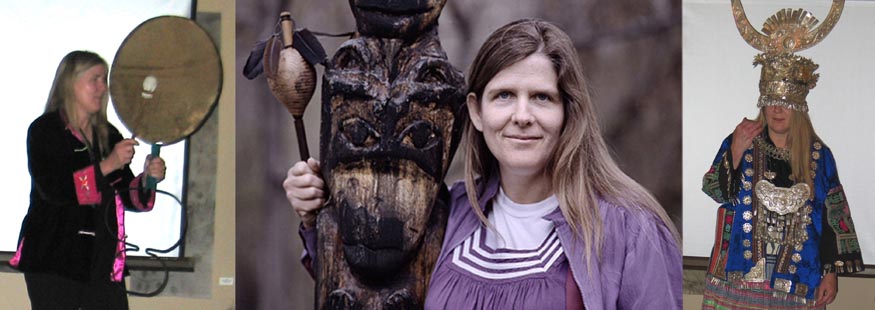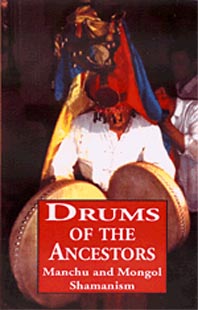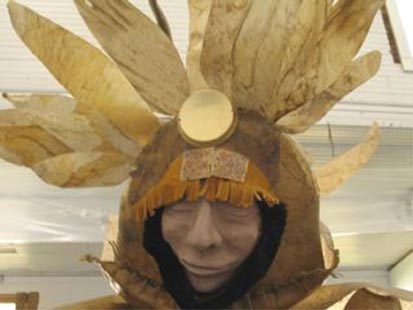
|
|


Image at right: Detail of sculpture by Susan Grimaldi, 'Dancing Shaman.'

Interviewer: Adam Silver, Executive Director of Asian Cultural Center of Vermont, Inc.
One of the offerings of Asian Cultural Center of Vermont in Brattleboro is a lecture on Asian Shamanic Culture by Susan Grimaldi. For further information, contact Adam Silver at (802) 257-7898, ext. 1 or accvt[at]myfairpoint[dot]net.
Susan Grimaldi became a dreamer at age seven and has practiced the art of visionary healing from the age of nineteen. She is a Field Associate with the Foundation for Shamanic Studies (FSS), specializing in audio - visual documentary work with tribal shamans from around the world. She has a M.Ed. in counseling psychology from Antioch University and has served on the faculty at Goddard College. She practices spiritual healing in Montpelier, Vermont, and she is a frequent lecturer at universities and medical schools on the topic of shamanism.
Susan spoke with Adam Silver, Executive Director of Asian Cultural Center of Vermont (ACCVT) about the work of shamans including Asian shamanic culture.
ACCVT: What is a shaman? What does it mean to be a shaman? What does a shaman do?
SUSAN: The word, shaman, comes from the Tungusic people of northern China. A shaman is the member of a community who has a special gift of vision. The gift can be inherited. It can be come through a serious illness or from a spontaneous awakening. The first shamanic experience can be overwhelming and take many years to understand and cultivate. When a person has this special gift there is often a compelling need to explore and develop their ability. By embracing their gift, the shaman can become whole and healthy. What distinguishes the shaman is the state of consciousness. Shamans master the ability to walk in two realities at once.
ACCVT: What is it like, this special gift of vision?
SUSAN: The shaman knows the nature of suffering and holds the ability to seek a vision of the healing. This understanding taps into a collective source of human wisdom. Healing comes from nature. The vision informs the shaman as the healing is conveyed. This guidance brings the suffering person back to a state of ease. The shaman can travel outside of time to when the ‘dis-ease’ first occurred. By re-dreaming the experience, solutions are experienced, the suffering is removed and the purity of the soul’s essence is restored.
ACCVT: What does it mean to re-dream?
SUSAN: The dream swirls back in time to a moment when the soul was disturbed. I might see a child curled up in terror, agony and abandonment calling for help. The healing is the care, comfort and recovery of that lost, frightened child. The soul is made whole and the agony is finally soothed. Emptiness is filled as the soul-essence is restored. The dream becomes the healing. The shaman is there to rescue that child. Trust builds. The shaman invites the lost soul-essence: “Come away, come away, come back to yourself. Come back today.” The recovery is subtle, profound and energetic.
ACCVT: Tell us about some of the aspects of shamanic culture.
SUSAN: Well, there’s the drum, with its rhythm and overtones. Sonic vibration helps to shift the shaman’s state of consciousness. While in this heightened state, the shaman has the ability to receive direct revelation. Through arduous training, shamans develop the strength necessary to hold forces of nature and become instruments of healing. The shaman becomes intimately familiar with Creation, and the mystery of life.
Then, there’s the ritual clothing worn by the shaman. The headdress and belt are of special importance. The headdress is a crown that opens the top of the head so the human spirit can fly. The headdress also acts as a receptor providing for a flow of information, wisdom and natural energy. Often there are long, beautiful silk scarves flowing from the headdress. The shaman’s eyes are usually covered with fringe or a curtain of beads. This veil separates the shaman from the ordinary world and keeps their focus in the world of vision. A mirror or brass disk is attached to the front of the headdress as a source of protection, deflecting any intrusive energy. The belt has metal disks or cones that hang and clang together. The sound vibration of the metal helps sustain the shaman in their journey.
ACCVT: These days, what significance does shamanic culture have for people?
SUSAN: As humans, we rely on wisdom, insight and healing. Shamanism has provided humans with access to these great resources for thousands of years. By working with guidance and vision we are able to gain perspective and clarity, which helps us to find solutions for our problems. Shamanism cultivates our relationship with nature and is useful in helping us understand our environment.
ACCVT: You’ve mentioned that currently in China, there is a growing interest in reintegrating shamanism back into contemporary culture. Tell us something about this interest in China and how you see shamanism fitting into contemporary culture.
SUSAN: There is now a fascination and thirst for spiritual experience in China. Many people have shamanism as a part of their tradition and heritage. It is natural that they would gravitate toward these roots. People are getting interested in the cultural artifacts of their traditions. I think that there are going to be more and more studies in China on shamanism and many of these are going to focus on experiential applications for therapeutic settings. I have heard that scholars are particularly interested in developing programs using these shamanic techniques for working with troubled youth.